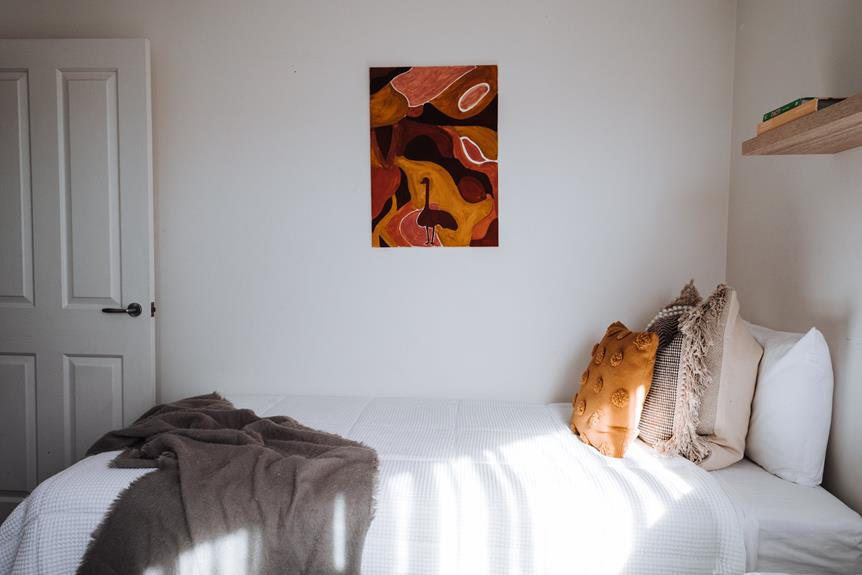Do you ever find yourself tossing and turning in bed, feeling uncomfortably sticky despite clean sheets?
Cotton, a popular choice for bedding, can sometimes leave you feeling clammy and sticky. Understanding why this happens can help you make informed decisions about your bedding.
Key Takeaways
- Cotton absorbs moisture from sweat and humidity in the air, leading to a sticky feeling.
- High humidity environments overwhelm cotton's moisture absorption capacity, causing dampness and prolonging stickiness.
- Cotton bedding traps moisture against the skin, intensifying the sticky feeling.
- Microbial colonization on cotton fabric can contribute to the unpleasant sensation, but opting for cotton fabrics with antimicrobial properties can minimize this.
Cotton's Absorption and Retention Properties
If you find that cotton makes you feel sticky in bed, it may be due to its high absorption and retention properties.
Cotton is known for its ability to absorb moisture, whether it's sweat from your body or humidity in the air. This means that when you're sleeping, especially in warm or humid conditions, cotton can quickly become saturated with moisture, leaving you feeling sticky and uncomfortable.
The moisture retention properties of cotton can also contribute to that sticky feeling. Once cotton absorbs moisture, it tends to hold onto it rather than wicking it away or allowing it to evaporate quickly. This can create a damp and clammy sensation, making you feel like the fabric is sticking to your skin.
When it comes to bedding, these absorption and retention properties can be particularly noticeable. If you're someone who perspires during the night or lives in a humid climate, choosing bedding made from materials with better moisture-wicking properties, such as bamboo or moisture-wicking synthetic fabrics, may help alleviate that sticky feeling.
Impact of Humidity on Cotton's Performance
How does humidity affect cotton's performance, and why does it contribute to the sticky feeling when sleeping in cotton bedding?
The impact of humidity on cotton's performance is significant. Cotton is known for its ability to absorb moisture, which is why it's a popular choice for clothing and bedding. However, in high humidity environments, the moisture absorption capacity of cotton can be overwhelming. When the air is already saturated with moisture, cotton struggles to absorb additional moisture, leading to a lingering dampness that can make you feel sticky and uncomfortable.
Additionally, the moisture that cotton does absorb in humid conditions takes longer to evaporate, prolonging the sensation of stickiness. This is further exacerbated when you're in direct contact with cotton bedding, as the fabric traps the moisture against your skin, intensifying the sticky feeling.
In essence, while cotton's moisture absorption properties are beneficial in normal conditions, they can become a drawback in high humidity environments, contributing to the unpleasant sensation of stickiness when sleeping in cotton bedding.
Interaction Between Cotton and Body Moisture
When your body releases moisture, such as sweat, it interacts with the cotton fabric, creating a sensation of stickiness and discomfort in bed. This interaction is influenced by the fabric composition and your body temperature.
Cotton, being a highly absorbent material, draws moisture away from your skin. However, when the fabric becomes saturated, it can no longer effectively absorb additional moisture, leading to a damp and sticky feeling. This is further exacerbated when your body temperature rises, causing increased perspiration and a higher level of moisture for the cotton to manage.
As the fabric composition and your body temperature play crucial roles in this interaction, choosing cotton bedding with a higher thread count can enhance its moisture-wicking properties. Additionally, managing your body temperature through proper ventilation or the use of moisture-wicking sleepwear can help reduce the discomfort caused by the interaction between cotton and body moisture.
Understanding these dynamics can empower you to make informed decisions when selecting bedding materials and managing your sleep environment.
Microbial Factors Affecting Cotton's Feel
You may notice that cotton can feel sticky in bed due to the presence of microbial factors affecting its texture and sensation. Microbial colonization on cotton fabric can lead to a sticky or unpleasant feeling, impacting your sleep experience. The composition of the fabric also plays a crucial role in how susceptible it is to microbial growth. Below is a table summarizing the microbial factors affecting cotton's feel:
| Microbial Factors | Description | Impact |
|---|---|---|
| Microbial Colonization | Presence of bacteria and fungi on the fabric surface | Can contribute to a sticky sensation in bed |
| Fabric Composition | The material makeup of the cotton fabric | Certain compositions may be more prone to microbes |
Understanding these microbial factors and their impact on cotton's feel can help you make informed decisions when choosing bedding materials. Consider opting for cotton fabrics with antimicrobial properties or proper maintenance to minimize microbial colonization and maintain a comfortable feel.
Chemical Treatments and Their Influence on Cotton
Chemical treatments significantly impact the overall feel and texture of cotton, influencing its comfort and tactile properties. When it comes to chemical treatments, it's essential to understand their influence on fabric composition. Here's a breakdown to help you grasp the impact:
- Chemical Treatments:
- Chemical treatments such as softeners, wrinkle-resistant finishes, and flame retardants alter the surface of cotton fibers, affecting how the fabric feels against your skin. These treatments can create a smoother or stiffer texture, which directly impacts your comfort level during sleep.
- Fabric Composition:
- The type and concentration of chemicals used in treatments play a crucial role in determining the fabric's composition. For instance, high levels of synthetic chemical finishes can make cotton less breathable and more prone to retaining heat and moisture, leading to a sticky feeling. Understanding the composition resulting from these treatments can help you make informed decisions when selecting bedding and clothing.
Comparison With Other Bedding Materials
When it comes to comparing cotton with other bedding materials, you may wonder about the breathability of silk and the moisture-wicking properties of linen.
Understanding how these factors differ can help you make an informed decision about the best bedding material for your needs.
Let's explore how cotton stacks up against silk and linen in terms of comfort and functionality.
Cotton Vs. Silk Breathability
Cotton's breathability, compared to silk and other bedding materials, plays a significant role in how comfortable you feel while sleeping. When comparing silk and cotton, silk comfort surpasses cotton due to its natural temperature-regulating properties, making it ideal for both warm and cool nights. Additionally, silk's breathability allows for better moisture absorption and evaporation, keeping you dry and comfortable throughout the night.
In contrast, cotton, while also breathable, may not offer the same level of moisture-wicking as silk, potentially leaving you feeling sticky in bed. When considering other bedding materials, such as linen or bamboo, silk still stands out for its unmatched breathability and luxurious feel. Understanding these differences can help you make an informed decision when choosing the best bedding material for your comfort and sleep quality.
Linen's Moisture-Wicking Properties
Feeling sticky in bed? Consider linen, known for its exceptional moisture-wicking properties when compared with other bedding materials. Linen's moisture-wicking ability makes it a favorable choice for those seeking a cooler and drier sleep experience. When comparing linen vs. cotton breathability, linen outperforms cotton in its moisture-wicking capabilities, ensuring that sweat and moisture are quickly absorbed and evaporated, keeping you comfortable throughout the night. For those looking for natural fiber alternatives, linen stands out as an excellent choice due to its moisture-wicking properties, breathability, and durability. Below is a comparison table of linen, cotton, and silk to highlight their moisture-wicking and breathability characteristics:
| Bedding Material | Moisture-Wicking | Breathability |
|---|---|---|
| Linen | High | Excellent |
| Cotton | Moderate | Good |
| Silk | Low | Moderate |
This table showcases the superior moisture-wicking and breathability properties of linen compared to cotton and silk, making it a top choice for a comfortable and dry sleep environment.
Tips for Minimizing Cotton-Induced Stickiness
To minimize cotton-induced stickiness in bed, try using a light, breathable cotton fabric and consider incorporating moisture-wicking bedding materials. Opt for cooling fabrics like lightweight cotton with a percale weave, which promotes better airflow and helps to keep you cool and dry throughout the night. Additionally, prioritize moisture control by investing in bedding made of performance fabrics such as bamboo or Tencel, which are known for their moisture-wicking properties.
- Cooling Fabrics
- Look for cotton with a percale weave for improved breathability.
- Consider bamboo or Tencel bedding for their excellent moisture-wicking capabilities.
Frequently Asked Questions
How Does the Production of Cotton Impact Its Feel in Bed?
The impact of farming on cotton production affects its feel in bed. Textile manufacturing processes also play a significant role. Understanding these factors helps you make informed decisions about the type of cotton bedding you prefer.
What Are the Environmental Factors That Can Affect the Stickiness of Cotton in Bed?
Environmental factors, such as humidity levels, can affect the stickiness of cotton in bed. Fabric composition, textile manufacturing, and the dyeing process all play a role in how cotton feels against your skin.
Are There Any Health Risks Associated With the Stickiness of Cotton in Bed?
Feeling sticky in bed due to cotton can impact your comfort level and potentially lead to skin irritation or allergies. Understanding the health implications can help you make informed choices for a better sleep experience.
Can the Thread Count of Cotton Bedding Affect Its Stickiness?
Yes, thread quality and weaves can affect the stickiness of cotton bedding. Fabric conditioning and proper laundering can also make a difference. Higher thread count and tighter weaves generally result in less stickiness.
How Does the Type of Cotton (E.G. Organic, Egyptian, Etc.) Affect Its Feel in Bed?
The type of cotton affects its feel in bed. Organic cotton enhances comfort level, while Egyptian cotton offers superior breathability. Understanding these differences can help you choose the best option for a cozy and comfortable night's sleep.
- How Does Ring Spun Cotton Affect Garment Fit and Shape Retention? - August 13, 2024
- What Are the Challenges in Producing Ring Spun Cotton? - August 13, 2024
- Is Ring Spun Cotton Suitable for Plus-Size Clothing? - August 13, 2024







